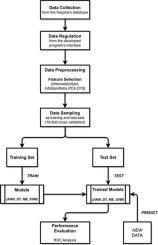Engineering Science and Technology, an International Journal ( IF 5.7 ) Pub Date : 2021-01-07 , DOI: 10.1016/j.jestch.2020.12.003 Tuba Karagül Yıldız , Nilüfer Yurtay , Birgül Öneç

|
The most common blood disease worldwide is anemia, defined by the World Health Organization as a condition in which the red blood cell count or oxygen-carrying capacity is insufficient. As both a disease and a symptom, this condition affects the quality of life. Early and correct diagnosis of the type of anemia is vital in terms of patient treatment. The increasing number of patients and hospital priorities, as well as difficulties in reaching medical specialists, may impede such a diagnosis. The present work proposes a system that will enable the recognition of anemia under general clinical practice conditions. For this system, a model constructed using four different artificial learning methods. Artificial Neural Networks, Support Vector Machines, Naïve Bayes, and Ensemble Decision Tree methods are used as classification algorithms. The models are evaluated with a dataset of 1663 samples and used 25 attributes, including hemogram data and general information such as age, sex, chronic diseases, and symptoms to diagnose 12 different anemia types. Data are collected by examining patient files at a university hospital in Turkey. In addition to all the data used by the doctors, the model also utilized eight different datasets created via particular feature selection techniques. The interface is designed to provide decision support to both medical consultants and medical students. Data are classified using the four different algorithms and an acceptable success ratio is obtained for each. Each model is validated using Classification Error, Area Under Curve, Precision, Recall, and F-score metrics in addition to Accuracy values. The highest accuracy (85.6%) achieved using Bagged Decision Trees, followed by Boosted Trees (83.0%) and Artificial Neural Networks (79.6%).
中文翻译:

使用人工学习方法对贫血类型进行分类
世界范围内最常见的血液疾病是贫血,世界卫生组织将其定义为红细胞计数或携氧能力不足的疾病。这种疾病既是疾病又是症状,会影响生活质量。就患者治疗而言,早期和正确诊断贫血类型至关重要。越来越多的患者和医院优先事项,以及难以联系到医疗专家,可能会阻碍这种诊断。本工作提出了一种在一般临床实践条件下能够识别贫血的系统。对于该系统,使用四种不同的人工学习方法构建的模型。人工神经网络,支持向量机,朴素贝叶斯和集成决策树方法用作分类算法。该模型使用1663个样本的数据集进行了评估,并使用了25个属性,包括血流图数据和一般信息,例如年龄,性别,慢性疾病和症状,以诊断12种不同的贫血类型。通过在土耳其的一家大学医院检查患者档案来收集数据。除了医生使用的所有数据外,该模型还利用了通过特定特征选择技术创建的八个不同数据集。该界面旨在为医学顾问和医学生提供决策支持。使用四种不同的算法对数据进行分类,并为每种算法获得可接受的成功率。除“精度”值外,还使用“分类误差”,“曲线下面积”,“精度”,“召回率”和“ F分数”度量标准来验证每个模型。最高准确度(85。



























 京公网安备 11010802027423号
京公网安备 11010802027423号